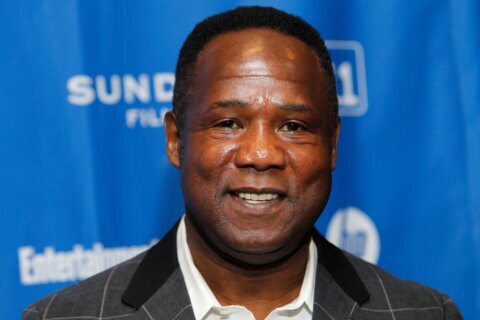The following information is provided by Graphiq and PrettyFamous.
By Ben Taylor

If you want to know about Hollywood peaks, just ask Bruce Willis. After annihilating terrorists as Officer John McClane in “Die Hard,” Willis exploded into outer space with Michael Bay’s 1998 smash hit, “Armageddon.”
A year later, he became a therapist, pivoting to a softer, more nuanced role in M. Night Shyamalan’s “The Sixth Sense.” Not only could Willis light up a room of goons — he could captivate the world from the side of a hospital bed. No matter what the subject, Willis had become a box office guarantee.
Or had he?
Since 1999, Willis has hit a box office slump. Here and there, his films have crossed the $100 million mark, but largely on the strength of reboots and get-the-band-back-together gimmicks (see “Live Free or Die Hard” and “The Expendables”). His biggest box office success since Haley Joel Osment saw dead people? “Over the Hedge,” a 2006 DreamWorks animation feature, where Willis did voice work for RJ the Raccoon.
Bruce Willis isn’t alone. PrettyFamous, a celebrity and entertainment data site that’s part of the Graphiq network, set out to find the actors with the biggest career declines, using box office proceeds as a measurement for success.
Ranking Hollywood’s biggest decliners is tricky. Some actors fade gradually. Others fall fast, then recover. Still others decline in a roller coaster of alternating hits and flops.
In the end, the PrettyFamous team used the following factors to rank Hollywood’s biggest falls from box office grace. Most of the data comes from Gracenote, with some supplementary numbers from Box Office Mojo (all figures are domestic and adjusted for inflation):
- Only actors whose movies have grossed a combined $2 billion were considered
- The actor had to have at least 10 film credits both before and after the “peak” film (the actor’s most lucrative movie)
- The actor’s post-peak movies had to average less than half the box office gross of all the pre-peak movies
- No post-peak film could exceed $200 million or 75 percent of the peak film’s gross
The resulting decliners enjoyed frequent box office success, followed by frequent box office disappointment. The final list is ranked by the difference between average box office proceeds for all films before and after the actor’s peak.
The 10 Biggest Decliners
- Ving Rhames
- Robert De Niro
- Dennis Quaid
- Keanu Reeves
- Matthew Broderick
- Bruce Willis
- Cuba Gooding Jr.
- Bill Pullman
- Sigourney Weaver
- David Thewlis
Note that the list is based on the money, not the individual performances. The methodology doesn’t factor in critic reviews or awards, and there’s no adjustment for the prominence of each actor’s specific role. Additionally, comprehensive box office data is limited or incomplete for some movies, particularly those made before 1985. Our coverage is close to comprehensive after that year, but we excluded actors who peaked before then, due to a lack of reliable data.
Still, there’s enough data here to suggest the 10 stars on the list have passed their primes. What happened?
The Textbook Cases
Bill Pullman: recent movies make $60 million less than earlier movies
Cuba Gooding Jr.: recent movies make $54 million less than earlier movies
Dennis Quaid: recent movies make $15 million less than earlier movies
Bill Pullman made a name for himself playing the boyfriends and husbands of female stars, from Earl Mott (“Ruthless People”) to Bob Hinson (“A League of Their Own”) to Walter (“Sleepless in Seattle”). His patience paid off with “Independence Day,” where he won his biggest role yet in President Thomas J. Whitmore — second only to Will Smith on the movie poster. The film made almost $500 million domestically.
But that would just about do it for Pullman, whose films would surpass the $50 million mark only two more times throughout the rest of his career. It’s possible that Pullman simply cares less about box office glory than the average actor, content to pursue other passions and hobbies in his spare time. For a man who gravitates towards smaller, supporting roles, it’s oddly fitting that he had an uncharacteristic high point playing the highest office in America.
Gooding’s decline — both in the box office and among critics — has been well chronicled in the film blogosphere. With “A Few Good Men,” “Jerry Maguire,” “As Good As It Gets,” and most lucratively, “Pearl Harbor,” Gooding looked poised to become the next Tom Hanks or Will Smith.
Then the flops began. First, there was “Snow Dogs.” Then “Radio.” Then “Daddy Day Camp.” Some did okay in the box office. All were panned by critics. Gooding was nominated four times for “Worst Actor” by the infamous Golden Raspberry Awards. Unable to break out of his spiral, Gooding settled for a dozen direct-to-DVD films from 2008 through 2013.
The box office success of “Snow Dogs” ($107 million in 2016 dollars) might have paradoxically hurt Gooding’s career, potentially branding him as a goofy B-movie performer, rather than a serious leading man.
The silver lining? Gooding has made a small resurgence over the last three years. He can proudly add “Lee Daniels’ The Butler” and “Selma” to his résumé, while his recent TV series, “The People v. O.J. Simpson: American Crime Story,” has gotten rave reviews.
America’s favorite film father (see “Frequency,” “The Parent Trap,” “The Day After Tomorrow”), Dennis Quaid saw his box office stock rise steadily from 1987 through 2004. After a series of modest hits throughout the ‘90s, Quaid kickstarted his career prime with “The Parent Trap,” playing the well-intentioned dad who just happens to fall in love with the wrong woman.
He quickly became quarterback Jack ‘Cap’ Rooney in the classic football movie, “Any Given Sunday” (1999), then tacked on a supporting role in the 2000 hit, “Traffic.” By the time he was cast as Jake Gyllenhaal’s co-star in the controversial “Day After Tomorrow,” Quaid was as bankable as a cashier’s check.
So what happened? Quaid likely wasn’t super hero or action film material (with the possible exception of “G.I. Joe: Rise of the Cobra”). He kept up the dad shtick (2004’s “In Good Company”) and doubled down on the romantic comedy (2012’s “What to Expect When You’re Expecting” and “Playing for Keeps”), but none of these roles would capture the world’s attention like Lindsay Lohan’s befuddled father or America’s favorite veteran quarterback.
The Blockbuster Series Stars
David Thewlis: recent movies make $74 million less than earlier movies
Keanu Reeves: recent movies make $23 million less than earlier movies
Ving Rhames: recent movies make $9.4 million less than earlier movies
David Thewlis is a special case. As Remus Lupin (the quirky professor and part-time werewolf from the Harry Potter series), Thewlis enjoyed consistent box office success from 2004 to 2011. Since then, he’s starred in a string of lower-profile roles — from an impatient landlord (“War Horse”) to a cheerful mentor (“The Theory of Everything”).
The box office tends to favor some film genres more than others, such as action and fantasy. As older stars gravitate from dynamite to dialogue, from dragons to discourse, they tend to see a drop in box office proceeds, through no fault of their own.
For Thewlis – like many of his Potter co-stars — you’d be better off calling his box office decline a return to reality rather than a fall from grace.
It’s an old joke that Keanu Reeves is a bad actor, but give the man credit for “The Matrix” (1999), where the actor’s subdued, near-expressionless dialogue perfectly matched the role.
Reeves peaked with the Wachowski siblings’ “The Matrix: Reloaded” (2003), right around the time the viewing public started to have second thoughts about the Wachowskis’ creative genius. By the time “The Matrix: Revolutions” (2003) notched a 36 percent on Rotten Tomatoes, both the series and Reeves were clearly past their primes.
Without his Matrix success, perhaps Reeves would have landed more supporting roles in hit films (see his slacker boyfriend portrayal in the 1989 classic, “Parenthood”). Instead, Reeves had established himself as a leading man, and his hodgepodge of starring roles have only gotten worse — box office-wise, at least — since the turn of the millennium.
Sub out “Harry Potter” or “The Matrix” for “Mission: Impossible,” and you can say much of the same for Ving Rhames, who played computer hacker Luther Stickell in all five Mission: Impossible films (his role was uncredited in “Ghost Protocol”). Of his 10 films to surpass $100 million, half come from the Tom Cruise action series.
But to equate Rhames with Thewlis or Reeves wouldn’t quite be fair. Rhames’ non-Mission: Impossible hits include “Pulp Fiction” (1994), “Con Air” (1997) and “Entrapment” (1999). And that’s not to mention key supporting roles in both “Lilo & Stitch” (2002) and “I Now Pronounce You Chuck and Larry” (2007), each of which earned well over $100 million.
Rhames has been just quiet enough over the last 10 years to earn a spot on this list, but so long as the Mission: Impossible bullet train keeps running along, he’ll have plenty of opportunity for a box office resurgence.
The Late-Career Blockbuster
Sigourney Weaver: recent movies make $73 million less than earlier movies
Were it not for James Cameron’s “Avatar” — as of this writing, second all-time in the U.S. box office — Sigourney Weaver’s box office history would look much like other top female action stars. Weaver became a bonafide action heroine as the star of the Aliens franchise, then crushed the box office as the leading woman in the Ghostbuster films. Since that time, she’s had fewer and fewer prominent roles in hit movies, with the exceptions (“The Village,” “WALL-E”) dwarfed by the rule (“Tadpole,” “Cedar Rapids,” “Chappie”).
Weaver’s journey is a common phenomenon for women in Hollywood: more high-profile roles in their 20s and 30s, with fewer opportunities as they get older.
But Weaver’s portrayal of Dr. Grace Augustine in “Avatar” marks a dramatic uptick for the Manhattan-born actress. Director James Cameron — who also directed “Aliens” — brought back Weaver for his 2009 smash hit, which speaks to the power of ongoing director-actor collaboration. While Weaver hasn’t struck box office gold since “Avatar,” she’s slated to appear in “Avatar 2” (2018). In other words, Weaver looks poised to exit this list, stage right.
The Aging Veterans
Bruce Willis: recent movies make $46 million less than earlier movies
Robert De Niro: recent movies make $11 million less than earlier movies
Robert De Niro and Bruce Willis remain semi-bankable — they’re simply no longer the megastars they once were. For these two, their late-career box office results only look modest in the context of their early box office dominance.
Consider De Niro. From 1986 through 2008, he was averaging nearly two $50 million films per year (adjusted for inflation). Several cracked $150 million. He made “Analyze This” his gold standard in 1999, only to top it one year later with “Meet the Parents.” By 2004, he was as bankable as Leonardo DiCaprio (see “Meet the Fockers”).
His pace has since slowed to human-like levels, with “Silver Linings Playbook” and “American Hustle” his only bonafide, post-Focker hits (and that’s not to mention the boost each film likely received from co-stars Jennifer Lawrence and Bradley Cooper).
Still, there’s no shame in a veteran superstar teaming up with fresher talent for late-career success. Just ask Peyton Manning.
Ferris Bueller or Voice Actor?
Matthew Broderick: recent movies make $45 million less than earlier movies
While Matthew Broderick’s first genuine hit was “WarGames” (1983), he will always be known as Ferris Bueller, the cheeky, rebellious star of 1986’s “Ferris Bueller’s Day Off.”
By the box office, however, “Bueller” is only Broderick’s sixth most lucrative film, falling behind “Godzilla,” “Inspector Gadget,” “WarGames,” “Tower Heist,” and most notably, “The Lion King.”
In fact, “The Lion King” might serve as a good lesson for Broderick, whose Adult Simba voice helped earn Disney more than $600 million. Since the turn of the millennium, only five Broderick films have earned more than $45 million — and three of those five featured only Broderick’s voice (“Good Boy!” “Bee Movie,” “The Tale of Despereaux”). Put simply, he’d be perfect in “Zootopia 2.”
Explore Thousands of Actors and Visualizations on PrettyFamous







